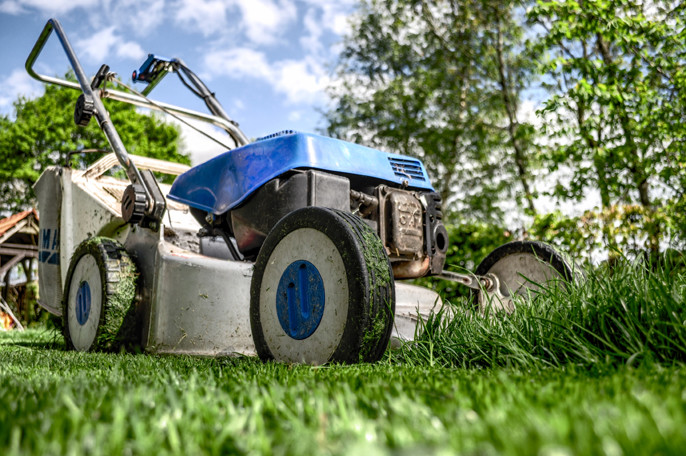Don’t let the grass grow under your feet – just level up your lawn mower instead.
Before Edwin Budding invented the world’s first lawn mower in 1830, we were all cutting our grass with scythes (imagine all the back-breaking effort!). Luckily, the humble lawn mower has gone from strength to strength and modern-day models come equipped with extraordinary capabilities. The only problem is, with all this choice available, how are you meant to select the lawn mower that best suits your needs?
This brief guide to contemporary, hi-tech lawn mowers is a great place to start. From the best time to update your current lawn mower, to what features to look out for, this article has you covered!
Time to upgrade
A lawn mower is a fantastic piece of modern engineering and a must-have tool for backyard maintenance so it’s no wonder that people can end up quite attached to their beloved machine. But all good things must come to an end, and if your current lawn mower isn’t up to scratch, your relationship with it should come to an end quickly!
The following signs are key indicators that its time for an upgrade.
1. a mysterious knocking sound
If you’re pestered by a knocking sound every time you cut the grass, we’ve got bad news for you. This could be the sign of a bent crankshaft or broken rod. Whether you have a domestic mower or a ride-on, a bent crankshaft is generally very expensive to repair, so you are often better off buying an entirely new model.
2. your engine vibrates in excess
To an extent, a vibrating engine is normal. But if you fear that your engine is seconds away from blasting off into space every time you are working in the backyard, it may be time to change things up. Keep in mind that an engine that vibrates to excess can also be a symptom of a bent crankshaft.
3. the exhaust is working overtime
Your exhaust pipe shouldn’t be billowing smoke. This can mean that you either need a new head washer, or that your engine is using too much fuel and is scoring your cylinder. The former is cheap to arrange, but the latter is not (and probably means you’re back on the market for a mower).
4. loss of power
If your mower isn’t cutting long grass like it used to, it could be a sign that it is losing compression. This is sometimes fixable, but again, if the cost of repairs outweighs buying a new model, it makes sense to start looking around.
Your first decision is going to have to be between petrol, battery (cordless) and electric type lawn mowers. If you made a poor decision with your previous mower, now is the time to rectify it once and for all. If you’re located on a large property, you’ll be undoubtedly opting for a ride-on mower.
Petrol mowers remain the machine of choice for those with big backyards to tend. If you’re purchasing a petrol lawn mower in Australia, it will more than likely have a four-stroke engine. This is because four-stroke engines run on unleaded petrol, which results in significantly less pollution. Whilst two-stroke engines are still around, last year the government passed further emissions laws that see two-stroke lawn mowers being phased out.
Electric type mowers are best suited for smaller yards. Contemporary models remain low maintenance to run, they don’t release pollution into the atmosphere. You do have to have access to well-placed power outlet, but this tends to be a non-issue in most smaller backyards.
If you were searching for battery powered lawn mower ten years ago, you would have been sorely disappointed. Many of the older battery powered models only gave you a mere fifteen minutes of power, the cutting power was nothing to write home about, and recharging took an exorbitant amount of time.
Today’s hi-tech models are far worthier of your time – they cut like any other modern mower, they’re low maintenance just like most electric mowers, and one charge typically gives you between 45 to 140 minutes of mowing time (depending on the brand).
You will also have to consider if you want a mulcher or catcher attached to your mower. The keen gardeners amongst us may want to consider models that have mulchers. These mowers take the fine grass clippings and compound them back into your lawn. Not only are these clippings unnoticeable (leaving you with a smooth and tidy lawn), they also help with the health of the grass itself. If your needs are more practical and less aesthetically motivated, a catcher model is fine. You simply bin the clippings once you’ve finished, and any escapees can easily be dealt with care of a broom or floor sweeper.
21st century benefits
Those old enough may be able to remember the early cylinder lawn mowers that were operated entirely by hand. Thankfully, the latest lawn mowers today are models of innovation.
As a rule of thumb, the larger the deck, the easier the cut. Look for brands that have a wide variety of decks on offer because they’ll be more likely to cater to your needs (whether they are purely domestic, or completely industrial).
If your yard has an incline, save your body the aches and pains now and look for a mower that’s self-propelled. When deciding on ride-on mowers, horse power and max speed are going to two of the deciding factors – there is no point bringing home a new ride-on if it means you’re still mowing for days at a time.
Crucially, your new lawn mower should be built tough. Unfortunately, you do get what you pay for and same goes for lawn mowers. If you are tempted to save a few pennies and go for a cheaper option or something second-hand, buyer beware (it probably won’t go the distance!)

